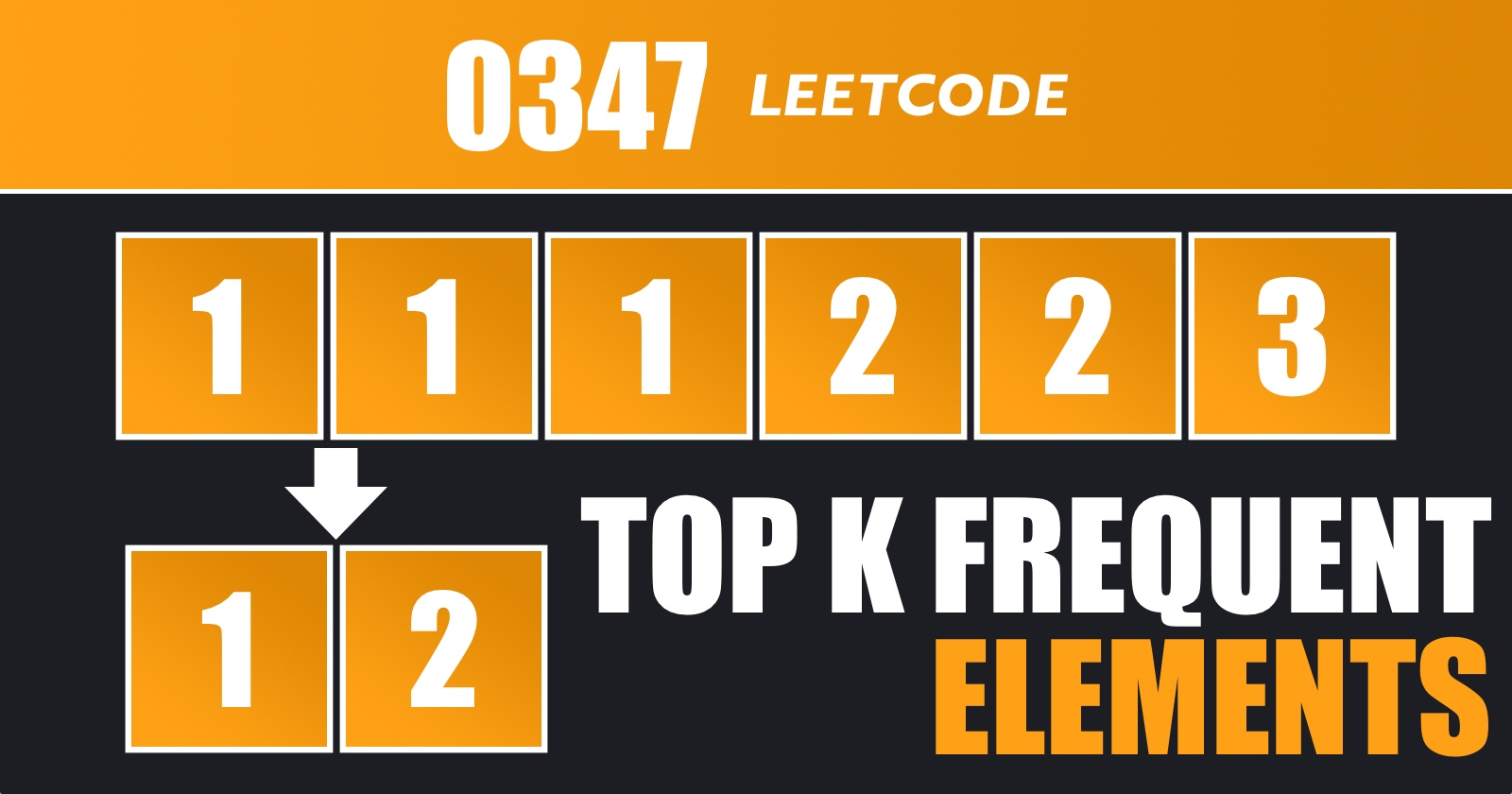Top K Frequent Elements - Leetcode 347
 Jyotirmoy Barman
Jyotirmoy Barman
Problem - Leetcode
Given an integer array nums and an integer k, return the k most frequent elements. You may return the answer in any order.
Example 1:
Input: nums = [1,1,1,2,2,3], k = 2
Output: [1,2]
Example 2:
Input: nums = [1], k = 1
Output: [1]
Constraints:
1 <= nums.length <= 10<sup>5</sup>-10<sup>4</sup> <= nums[i] <= 10<sup>4</sup>kis in the range[1, the number of unique elements in the array].It is guaranteed that the answer is unique.
Follow up: Your algorithm's time complexity must be better than O(n log n), where n is the array's size.
Answer-1 in Golang
func topKFrequent(nums []int, k int) []int {
countMap := map[int]int{}
for _, num := range nums {
if count, ok := countMap[num]; ok {
countMap[num] = count + 1
} else {
countMap[num] = 1
}
}
countSlice := make([][]int, len(nums)+1)
for num, count := range countMap {
countSlice[count] = append(countSlice[count], num)
}
res := []int{}
for i := len(countSlice) - 1; i > 0; i-- {
res = append(res, countSlice[i]...)
if len(res) == k {
return res
}
}
return res
}

This code defines a Go function called topKFrequent takes a slice of integer nums and an integer k as its parameters. The goal of this function is to find the k most frequent numbers from the input slice and return them in an output slice.
Here's how the code works:
countMap := map[int]int{}- This initializes an empty map called
countMap. The keys of this map will be the unique numbers from the input slice, and the values will be the frequency (count) of each number.
- This initializes an empty map called
Loop through
numsto populatecountMap:The loop iterates through each number
numin the input slicenums.If
numis already a key incountMap, it increments the count by 1.If
numis not a key incountMap, it addsnumto the map with a count of 1.
countSlice := make([][]int, len(nums)+1)- This creates a 2D slice called
countSlice. The outer slice will store lists of numbers grouped by their frequency. The inner slices will store the actual numbers.
- This creates a 2D slice called
Loop through
countMapto populatecountSlice:The loop iterates through each key-value pair in
countMap.It appends the number (
num) to the inner slice corresponding to its frequency (count) incountSlice.
Retrieve the
kmost frequent numbers:- The code initializes an empty result slice called
res.
- The code initializes an empty result slice called
Iterate through
countSlicein reverse order:Starting from the highest possible frequency (length of
countSlice- 1), it iterates in reverse.It appends the numbers in the current frequency group to the result slice
res.If the length of
resbecomes equal to or greater thank, it means the requiredkmost frequent numbers have been found, so the function returnsres.
If the loop completes without finding
kmost frequent numbers:- If the loop completes without returning, it means the total number of unique numbers is less than
k. In this case, it just returns theresslice.
- If the loop completes without returning, it means the total number of unique numbers is less than
In summary, this code calculates the frequency of each number in the input slice, groups the numbers based on their frequency, and returns the k most frequent numbers. The approach is based on using a frequency map and a frequency-based grouping in a 2D slice.
Answer-2 Top Runtime in Golang
import (
"math"
"sort"
)
func topKFrequent(nums []int, k int) []int {
n := len(nums)
if n < 2 {
return nums
}
min, max := math.MaxInt32, math.MinInt32
for _, val := range nums {
if min > val {
min = val
}
if max < val {
max = val
}
}
numRange := max - min
//[counter, index-to-next]
allCounters := make([][2]int, numRange+2)
firstValue := nums[0]
prevValue := firstValue - min +1
diffCount := 1
allCounters[prevValue][0] = 1
allCounters[prevValue][1] = -1
for _, val := range nums[1:] {
realVal := val - min + 1
allCounters[realVal][0] += 1
if allCounters[realVal][1] == 0 {
diffCount++
allCounters[realVal][1] = prevValue
prevValue = realVal
}
}
allPairs := make([][2]int, diffCount)
//fmt.Printf("#count: %v\n", diffCount)
idx := 0
for diffCount > 0 {
val := prevValue + min - 1
allPairs[idx][0] = allCounters[prevValue][0]
allPairs[idx][1] = val
prevValue = allCounters[prevValue][1]
idx++
diffCount--
}
sort.Slice(allPairs, func(i, j int) bool {
return allPairs[i][0] > allPairs[j][0]
})
res := make([]int, k)
idx = 0
for idx < k {
res[idx] = allPairs[idx][1]
idx++
}
return res
}
This code defines a function topKFrequent that takes an array of integers nums and an integer k as input and returns an array containing the top K most frequent elements in the input array. Let's break down the code step by step:
The
importstatements: The code imports the necessary packagesmathandsortfor mathematical operations and sorting, respectively.Function
topKFrequent: This function calculates the top K most frequent elements in thenumsarray.Calculating the length of the input array: The variable
nstores the length of thenumsarray.Handling edge cases: If the length of the array is less than 2, the function returns the original array as there won't be any "top K frequent" elements.
Finding the minimum and maximum values in the array: This loop iterates through the
numsarray and finds the minimum (min) and maximum (max) values.Calculating the range of values: The variable
numRangecalculates the range of values in the array by subtracting the minimum from the maximum value.Initializing an array for counters and indices: The
allCountersarray is created to store two values for each element: its frequency count and the index of the next element with the same frequency.Initializing variables:
firstValueholds the value of the first element in the array.prevValueis initialized with the adjusted value of the first element based on the minimum value.diffCountkeeps track of the number of unique frequencies encountered.
Storing frequency and index information:
The frequency of the first element is set to 1 in
allCounters.The index of the next element with the same frequency is set to -1.
Iterating through the array to count frequencies and indices:
This loop iterates through the
numsarray starting from the second element.It adjusts the current value based on the minimum value and stores it as
realVal.The frequency count of
realValis incremented inallCounters.If the index of the next element with the same frequency is 0, it means this is a new frequency. In that case,
diffCountis incremented, and the index is updated.
- Creating an array of frequency-value pairs:
- An array
allPairsis created to store the frequency-value pairs for the unique frequencies encountered.
- Populating the
allPairsarray:
This loop iterates until
diffCountbecomes 0.The original value is calculated by adding
min - 1to the adjusted value.Frequency and value are stored in
allPairs, and the next index is updated.
Sorting the pairs by frequency: The
allPairsarray is sorted in descending order based on frequency.Extracting the top K frequent elements:
An array
resis created to store the final result.The loop extracts the top K elements from
allPairsand stores their values inres.
- Returning the result: The function returns the
resarray containing the top K frequent elements in descending order of frequency.
This code implements a more complex algorithm to solve the problem of finding the top K most frequent elements by managing indices and frequencies directly.
Answer-3 Top Memory in Golang
func max(a, b int) int {
if a > b {
return a
}
return b
}
func min(a, b int) int {
if a < b {
return a
}
return b
}
type Pair struct {
fr int
sc int
}
func topKFrequent(nums []int, k int) []int {
mn, mx := nums[0], nums[0]
for _, v := range nums {
mn = min(mn, v)
mx = max(mx, v)
}
counter := make([]Pair, mx-mn+1)
shift := mn
for _, v := range nums {
counter[v-shift].fr += 1
counter[v-shift].sc = v
}
sort.Slice(counter, func(i, j int) bool {
return counter[i].fr > counter[j].fr
})
ans := make([]int, k)
for i := 0; i < k; i++ {
ans[i] = counter[i].sc
}
return ans
}
This code defines a function topKFrequent that takes an array of integers nums and an integer k as input and returns an array containing the top K most frequent elements in the input array. Let's break down the code step by step:
Function Definitions for max and min:
- Two utility functions
maxandminare defined. They return the maximum and minimum of two integer values, respectively.
- Two utility functions
Defining a Pair Struct:
- A custom data structure
Pairis defined to hold two integer values,fr(frequency) andsc(score/value). This will be used to store frequency-score pairs.
- A custom data structure
Function
topKFrequent:- This function calculates the top K most frequent elements in the
numsarray.
- This function calculates the top K most frequent elements in the
Finding the Minimum and Maximum Values in the Array:
The variables
mnandmxare initialized with the first element of thenumsarray.A loop iterates through the
numsarray and updatesmnandmxto find the minimum and maximum values.
Creating a Counter Array:
An array named
counterof typePairis created to store frequency-score pairs.The variable
shiftis set tomn. This will be used to adjust the index in thecounterarray so that the minimum value corresponds to index 0.
Populating the Counter Array:
Another loop iterates through the
numsarray.The frequency of the element
vis incremented in thecounterarray at the indexv - shift. The corresponding scorevis also stored.
Sorting the Counter Array:
- The
counterarray is sorted in descending order based on frequency. Thesort.Slicefunction is used with a custom comparison function that compares the frequencies of twoPairobjects.
- The
Extracting the Top K Frequent Elements:
An array
ansis created to store the final result.A loop iterates
ktimes.The score of the
i-th element in the sortedcounterarray is assigned to thei-th element of theansarray.
Returning the Result:
- The function returns the
ansarray containing the top K frequent elements.
- The function returns the
In summary, this code calculates the frequency of each element in the input array and stores the frequencies along with the corresponding values in a custom Pair structure. Then, it sorts the pairs based on frequency and extracts the top K elements by copying their values into the result array. This approach optimizes memory usage and avoids creating a separate map to store frequencies.
Subscribe to my newsletter
Read articles from Jyotirmoy Barman directly inside your inbox. Subscribe to the newsletter, and don't miss out.
Written by

Jyotirmoy Barman
Jyotirmoy Barman
I'm a developer who loves to write. I started my blog because I wanted to share my knowledge and passion for technology with others. I write about a variety of topics, including coding, web development, and blockchain.